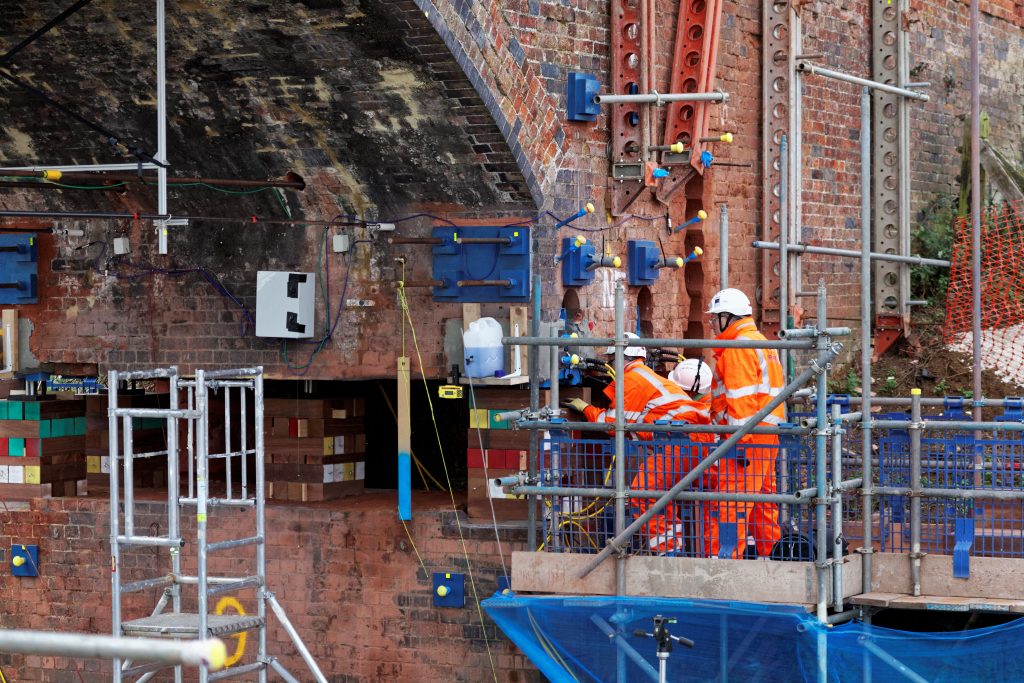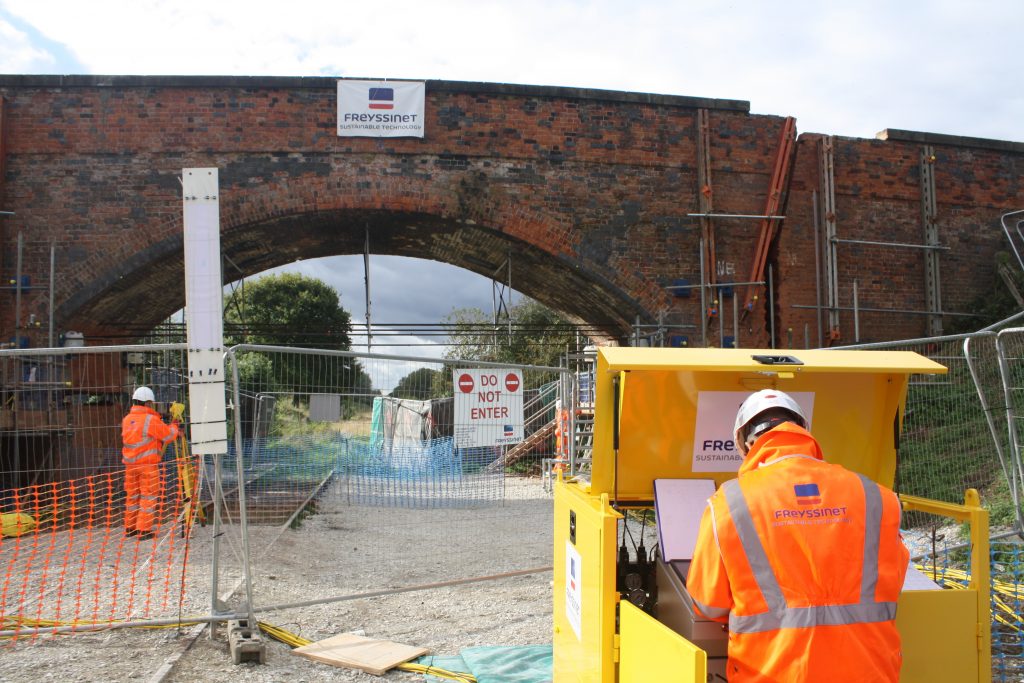Overheard at last year’s Most Interesting awards in Derby was this brief snippet of conversation: “Really?”… “That’s an intriguing concept.” Perhaps this would have been lost in the general hubbub of networking going on but for the obvious height- of-eyebrow-raising on the “Really?”, the splutter on the gin-and-tonic and the narrowing of the eyes accompanying the guarded reference to ‘an intriguing concept’. Could this have been, in fact, a lightly coded and polite version of “You’re off your trolley pal!”?
But, of course, surprise is everything. Reactions such as this are understandable when, out of the blue, a proposal to lift an entire brick arch clear of electrification wires is made – and made in all seriousness.
The background
Let us look, then, at the background to all of this. Why is such a concept being considered at all? After all, electrification schemes have been progressed for several generations already. Plenty of structures have been in the way and there are several well-established methods of getting round most of the problems.
These have involved either lifting the bridge or lowering the track – except that, in the case of brick or masonry structures, lifting has been seen as far too ‘intriguing’.
In short, it’s never been done before.
And why hasn’t it ever been done before? Let’s just consider what a brick arch consists of. It’s essentially just a pile of bricks carefully (usually) arranged in a specific order to hold itself up with some spare capacity to carry a little extra. If the structure is disturbed carelessly, then it will revert back to its original form of a pile of bricks – but this time the process happens very quickly. Not for nothing are they called gravity structures.
It’s not been done before because, for most engineers, it is all much too… adventurous… or even reckless.
Plain logical
But for one man, Bill Harvey, a well known and respected expert in brick and masonry arches, lifting an arch was just plain logical.
So long as the line of thrust is kept within certain parts of the arch ring then it will be possible to keep the whole structure stable. Arches may seem to be heavy, but modern jacking technology is perfectly capable of coping with the weight involved and with the required precision needed to manipulate the structure.
Bill knew that. Bill knew that over ten years ago! Understandably, others were less enthusiastic.
So what has changed? In one way, nothing. The physics are the same, the lifting technology is the same. Electrification and its disturbance of civil engineering structures is the same. But many disparate issues have all come together. The industry is more aware that, of all the costs of electrification, 25 per cent is spent on altering civils structures. Society is more appreciative of heritage structures, and wholesale demolition, which could occur even in World Heritage sites, is now actively questioned. Add to all this the disruption to train services in most of the normal methods of ensuring electrification clearances, and it becomes clear that there is a need to add a further option.
Summary demolition
The existing methods – as have been referred to previously – include track lowering, which may lead to long possessions and the disturbance of foundations. Deck raising has hitherto only been used for steel or concrete structures. If brick or masonry structures are in the way they have been summarily demolished.
Up to the 1970s, and maybe slightly later, the preferred option was simply to blow them away. It was preferred because it was quick – very quick – and, let’s be honest, really exciting! But carrying around and using explosives seems to have fallen out of favour.
More recently, demolition by specialised long-reach hydraulic peckers and nibblers has been very effective as they can be controlled with some element of precision. Whatever demolition method is adopted – exciting explosives or clinically efficient hydraulics – the end result is much the same. There is a pile of bricks that has to be loaded away without damaging the tracks or the signal cables.
Trying out an idea in real life
RSSB, in association with Network Rail, ran a competition in February 2014 with a view to finding a way of avoiding the disruption caused by the demolition of arch structures. The nature of such a competition is to bring together people and companies who may find that they have similar aims and facilities but who just need some seed cash to try out an idea in real life.
Such was the case with Bill and his concept. It really was a matter of cometh the hour, cometh the man, cometh the company (Freyssinet), cometh the combined proposal, cometh the business case and cometh a successful bid for a trial on a real bridge.
Freyssinet is a civil engineering company that specialises in the repair and strengthening of structures. It also has a reputation for moving things – at times, very large things. When Kevin Bennett and John Kennils of Freyssinet met Bill at the competition networking session, they immediately realised that the brick arch raising project was bold, but achievable – and definitely something they wanted to be involved in!
It is not easy to find a practice bridge, but one fitted the bill on the mothballed East -West route near Milton Keynes. Moco Farm bridge is a simple single span brick arch carrying a narrow farm track. It was built in 1850 for the line engineered by Robert Stephenson. It has a clear span of 10.1m and appeared to be in reasonable condition. It was also in the back of beyond.
The farmer was amenable to the trial and a temporary access road and level crossing was installed so that his daily activities and those of his herd could continue unhindered.
Carefully does it
The bridge was thoroughly examined, its parapets were stabilised and, gradually, the fill was removed down to the barrel of the brick arch and the abutment chambers. This was like shaking hands with the original craftsmen as the original framework of the structure was carefully exposed, with construction details very close to those on the original plans. But, as is so often the case with structures of this age, there were a few surprises. Separation cracks that seemed small on the outside were not so small within the body of the structure. Brick headers in the parapet did not carry through, but were what is known as snap-headers – effectively a cheat by the brickies.
In order to be sure that the arch, its spandrels and abutment diaphragms stayed intact, a number of strengthening measures were taken. Belts and braces were in evidence, but why not? This was a world first.
The next challenge was to separate the arch, spandrels and parapets from the footings to allow the whole superstructure to be lifted – or rather, to be jacked up.
Vertical and horizontal components
At this point, fundamental engineering comes to the fore. The precise line of thrust from the arch can be a little vague. It will be within certain limits, but the best way to cope with this variation is to resolve the thrust into vertical and horizontal components.
The vertical is relatively simple and can be accommodated with the jacking system.
The horizontal is taken by a pair of vertical slide plates inserted in a vertical groove in the four wing walls. Above the slide plates, the grooves are angled back to allow the arch to rise without becoming snagged.
Centrally controlled hydraulic climbing jacks are located at each corner and at mid points on the abutments and the abutments horizontally separated with a wire saw cut.
Precise monitoring is carried out, so making sure that every jack rises at the same rate. In addition to an impressive array of electronic sensors, there was a fallback in the form of a water level. This is something that would have been familiar to the builders of the pyramids.
Live demonstration
On Thursday 26 October, the industry was invited to a live demonstration of the lift and, of course, Rail Engineer was there. Quite a crowd had answered the call, mainly of people and organisations interested in witnessing something rather extraordinary and something very brave.
The Railway Heritage Trust came along, as there is now an alternative to the wholesale destruction of heritage brick arches. A raised arch will mean a raised parapet and possibly raised string courses, but there are legitimate ways in disguising cut lines in existing vertical features.
Others at the demonstration included representatives of design houses charged with solving many of the usual problems associated with electrification and structural clearances.
The ElevArch team – that’s Freyssinet and Bill Harvey – acknowledge that this technique is not the only option to solve the issue of brick arches, but it does bring to the table another way of doing things and one that can be considered as a legitimate technique along with track lowering and demolition.
And what of the live lift? While some may have been sceptical and some downright doubtful, awaiting with glee to witness a new pile of bricks, Bill and the Freyssinet team were more relaxed than many had anticipated. At about five minutes for every 100mm lift and a pause for re-packing the jacks, the process is not fast. It does not need to be. With all the preparatory works being carried out behind safety barriers and without the need for possessions, the only blockage needed to complete the lift could be just a normal rules of the route possession. Six hours would be sufficient to mobilise the jacking system and to complete the series of 100mm lifts and inspections.
The demonstration bridge was lifted a total of 900mm to demonstrate the scale of what is achievable by this patented technique.
Once in position, the jacks would be removed for reuse, the vertical slides would be grouted in and the whole structure gradually reinstated but with the deck at the new required height.
Confidence
So yes, the live lift was a success. Lifting a brick arch is possible, although Bill never doubted it. The ElevArch team knows that the technique can be improved still further. The aim is to get a feel for what preliminary works are really necessary and to ensure that the exercise is commercially viable. The rail network has about 500 such bridges, although not all are contenders for ElevArch.
It will be interesting to overhear the conversations at the next Most Interesting awards in Derby. The ‘intriguing concept’ has proved itself. No need to choke on the gin-and-tonic this time.
Written by Grahame Taylor




